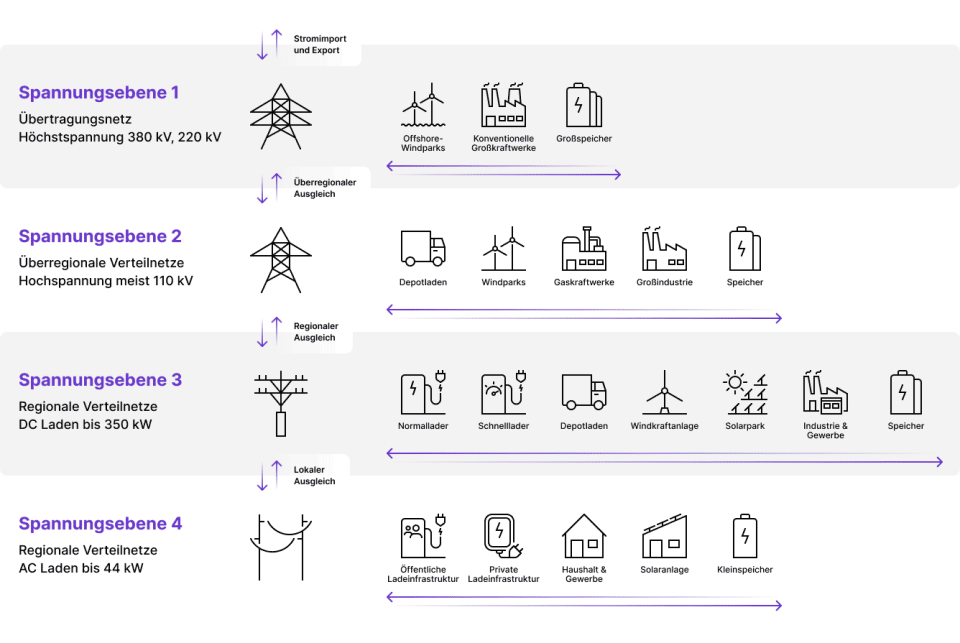Charging on the go: regular vs. fast charging – what are the differences?
How long it takes to charge an EV is often an important purchasing decision. But what ways are there to charge your vehicle on the go? Here’s an overview.
Not only is choosing the right electric vehicle a difficult decision - the question of the optimal charging option also concerns many electric car owners. But what are the biggest differences between public charging stations? And what other offers are there? This blog article takes you on a journey through the world of charging technologies.
AC charging stations in public spaces
The fact of the matter is, a crucial point for charging stations is its charging performance. AC (alternating current) charging stations in public spaces with up to 22 kW charging power are the current standard, but can vary depending on the model and manufacturer. These columns are suitable for everyday charging, but typically require several hours to fully charge the battery.
These charging stations are mostly installed in places such as parking lots, shopping centers, businesses and public places. They are well suited for daily charging of electric vehicles for longer periods of time. For example, a model ID.3 car can be fully charged in five to seven hours with 11 kW charging power, depending on the battery size.
Don't waste time on the go: how fast charging stations work
Fast charging stations are designed to significantly reduce waiting times. By using modern technologies such as direct current (DC) transmission, they enable rapid charging in a shorter time. While conventional charging stations are distributed throughout cities, fast charging stations are often found in strategic locations for long-distance journeys, such as motorway service stations.
This ensures that electric vehicles are quickly ready for use again, even on long journeys. The charging power currently reaches up to 300kW. For example, an ID.3 could be charged from 5 to 80 percent in around 30 minutes.
These technical features characterize fast charging stations:
1. Direct current (DC) instead of alternating current (AC)
The main difference between AC charging stations and DC fast charging stations is the type of electricity provided. While conventional charging stations usually use alternating current (AC), fast charging stations use direct current (DC). Direct current allows energy to be transferred more efficiently, resulting in shorter charging times.
2. More powerful hardware
Fast charging stations are equipped with more powerful hardware to enable higher charging performance. This includes more powerful chargers and more efficient cooling mechanisms to ensure that the electric vehicles can be charged quickly and stably at the same time.

3. Power connection
Fast charging stations are often connected to the medium-voltage network, which makes it possible to transmit large amounts of electrical energy at higher voltages. This helps reduce charging time as more power can be transferred.
4. Communication with the vehicle
Modern electric vehicles are equipped with advanced communication systems that make it possible to communicate effectively with the charging station. This communication enables optimized control of the charging process and ensures that the vehicle can use the maximum power of the fast charging station. This not only ensures fast charging, but also safe charging.
5. Battery Management System (BMS)
The electric vehicle's battery management system plays a crucial role in fast charging. It monitors and controls the charging process to protect the battery from overheating or other harmful effects. The BMS ensures that the battery is charged efficiently and safely and is prepared for charging.
6. Cooling technologies
Fast charging stations often have advanced cooling technologies to effectively dissipate the heat generated during fast charging. This is important to extend the life of the station and avoid excessive temperatures during charging. Some charging cables even offer water cooling.
HPC charging stations
Those who are in a real hurry can now also rely on HPC charging stations. With these charging stations it is possible to achieve charging outputs of several hundred kilowatts, which ensures extremely short charging times. While normal DC charging stations offer between 50 and 100kW charging power, HPCs have charging power from 100 to 350kW.
Important: Not all electric vehicles are able to use the maximum performance of fast charging stations. The charging performance depends on the technical specifications of the vehicle. Typically, high-end electric vehicles and new models support higher power fast charging.
Full flexibility with backup battery charging stations
Backup battery charging stations provide even more flexibility and can be set up in locations that are not intended for high charging outputs due to space or infrastructure reasons (no medium voltage available). They are perfect for parking lots, gas stations or areas without a fixed charging infrastructure where only the low-voltage network is available.
The innovative Flexpole charging station from Elli can be set up almost anywhere. When connected to the low-voltage network, it becomes a permanent charging point. In this way, the Elli Flexpole charging station saves you the civil engineering work and the complex medium-voltage network connection that charging stations usually entail. You simply set up the charging station where it is needed, connect it to the 400V low-voltage network and you can offer a charging point with up to 150 kW charging power.
